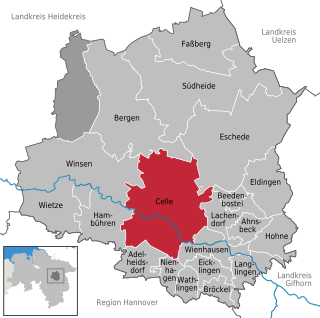
Celle is a town and capital of the district of Celle, in Lower Saxony, Germany. The town is situated on the banks of the river Aller, a tributary of the Weser and has a population of about 71,000. Celle is the southern gateway to the Lüneburg Heath, has a castle built in the Renaissance and Baroque style and a picturesque old town centre with over 400 timber-framed houses, making Celle one of the most remarkable members of the German Timber-Frame Road. From 1378 to 1705, Celle was the official residence of the Lüneburg branch of the dukes of Brunswick-Lüneburg who had been banished from their original ducal seat by its townsfolk.
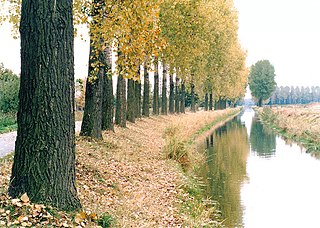
The Aller is a 215-kilometre (134 mi) long river in the states of Saxony-Anhalt and Lower Saxony in Germany. It is a right-hand, and hence eastern, tributary of the Weser and is also its largest tributary. Its last 117 kilometres (73 mi) form the Lower Aller federal waterway (Bundeswasserstraße). The Aller was extensively straightened, widened and, in places, dyked, during the 1960s to provide flood control of the river. In a 20-kilometre (12 mi) long section near Gifhorn, the river meanders in its natural river bed.

The Oker is a river in Lower Saxony, Germany, that has historically formed an important political boundary. It is a left tributary of the River Aller, 128 kilometres (80 mi) in length and runs in a generally northerly direction.
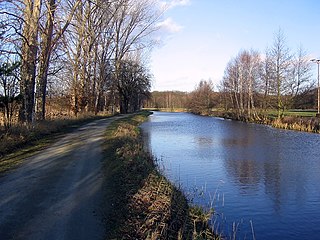
The Ohre is a river in northern Germany, left tributary to the Elbe. Its total length is 103 kilometres (64 mi). Its source is north of Wolfsburg, in Lower Saxony. It flows generally south-east, at first following the border of Lower Saxony and Saxony-Anhalt. After Buchhorst it flows completely through Saxony-Anhalt, along the Mittellandkanal. It flows into the Elbe in Rogätz, north of Magdeburg. The towns Brome, Calvörde, Haldensleben and Wolmirstedt lie along the river. The upper course of the Ohre is in the Drömling nature reserve.
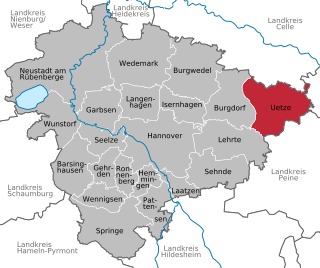
Uetze [ˈʏt͡sə] is a municipality in the district of Hanover, in Lower Saxony, Germany. It is situated on the river Fuhse, approximately 35 km (22 mi) east of Hanover.
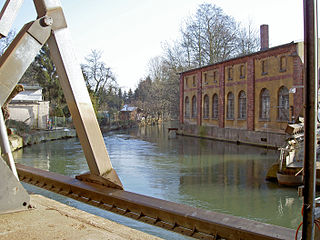
The Innerste is a river in Lower Saxony, Germany. It is a right tributary of the Leine river and 101 km (63 mi) in length.

Lutter is a small river in the Lüneburg Heath, Lower Saxony, Germany, right tributary of the Lachte.
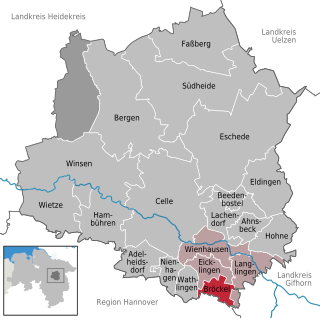
Bröckel is a municipality in the district of Celle, in Lower Saxony, Germany. It belongs to the collective municipality of Flotwedel with its seat in Wienhausen.
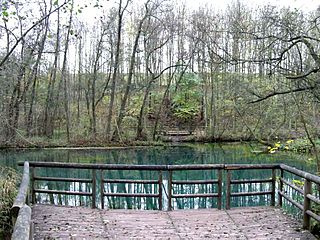
The Rhume is a 48 km (30 mi) long river in Lower Saxony, Germany. It is a right tributary of the Leine. Its source is the karstic spring of Rhume Spring in Rhumspringe, south of the Harz mountain range. The water drains with high pressure from the ground of the funnel-shaped well, known for its turquoise colour.

Örtze is a river of Lower Saxony, Germany. The Örtze rises north of Munster in the Große Heide and, after 62 kilometres (39 mi), joins the Aller southeast of Winsen.
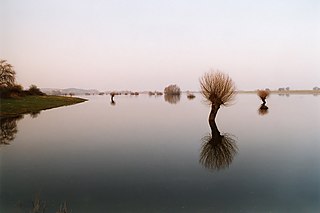
The river Jeetzel, which begins in the Altmark under the name Jeetze, flows from Saxony-Anhalt through Lower Saxony, in Germany. From its source near the village of Dönitz, it flows north through Beetzendorf, Salzwedel, Wustrow, Lüchow and Dannenberg, before joining the Elbe in Hitzacker. Its total length is 73 kilometres (45 mi).
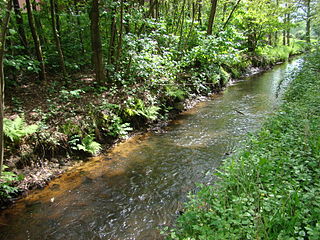
Meiße is a river of Lower Saxony, Germany that flows through part of the Lüneburg Heath. It is a right-hand tributary of the Aller.

The Lachte is a 38-kilometre-long (24 mi) right-hand tributary of the Aller in the Südheide Nature Park in the north German state of Lower Saxony.

Altencelle is part of the borough of Celle in Lower Saxony and lies southeast of the town centre, west of the River Aller and east of the Fuhse. It is linked to Celle by the B 214 federal road and state highway K 74.

Westercelle is a suburb of the district town of Celle in Lower Saxony, Germany, that lies 3 kilometres south of the town centre on the river Fuhse.

The Bundesstraße 214 is a federal road that runs from Lingen to Brunswick in North Germany.

Wietze is a river of Lower Saxony, Germany, a tributary of the Aller. Its total length including its source river Edder is 41.0 km (25.5 mi).
The Aller Canal is a canal built in the mid-19th century in the German state of Lower Saxony. The canal is 18 kilometres (11 mi) long and runs between Wolfsburg and Gifhorn. It was built to protect agricultural land from flooding by the river Aller. The nearly straight canal carries water from the Aller more quickly than the river itself can in its meandering course through this section of the old glacial valley.

The Ise is a 43 km (27 mi) long, almost natural river of East Lower Saxony and Saxony-Anhalt, Germany. It crosses the district of Gifhorn from north to south and discharges into the Aller at Gifhorn itself.


















